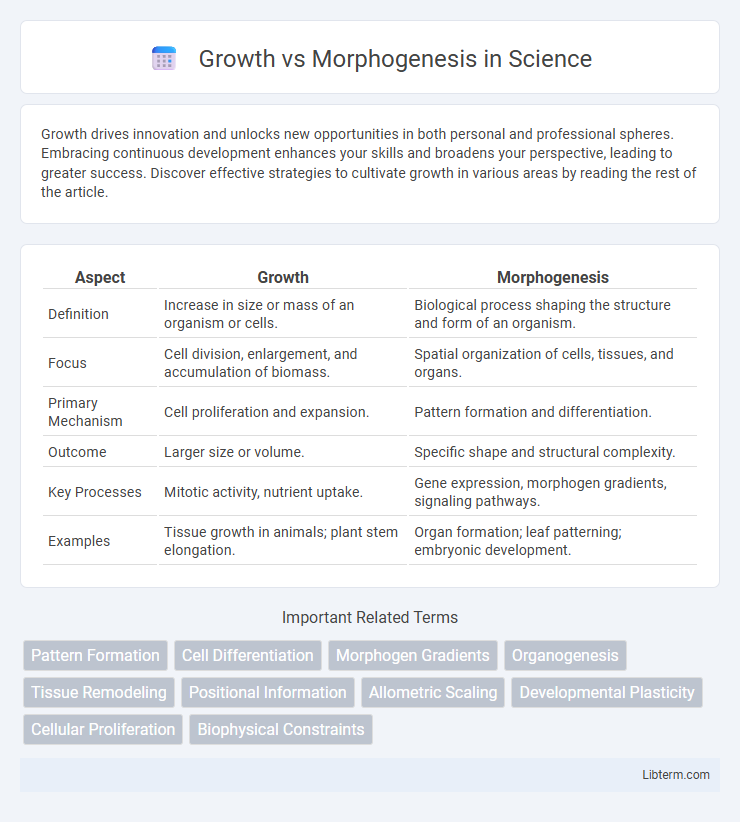Growth drives innovation and unlocks new opportunities in both personal and professional spheres. Embracing continuous development enhances your skills and broadens your perspective, leading to greater success. Discover effective strategies to cultivate growth in various areas by reading the rest of the article.
Table of Comparison
| Aspect | Growth | Morphogenesis |
|---|---|---|
| Definition | Increase in size or mass of an organism or cells. | Biological process shaping the structure and form of an organism. |
| Focus | Cell division, enlargement, and accumulation of biomass. | Spatial organization of cells, tissues, and organs. |
| Primary Mechanism | Cell proliferation and expansion. | Pattern formation and differentiation. |
| Outcome | Larger size or volume. | Specific shape and structural complexity. |
| Key Processes | Mitotic activity, nutrient uptake. | Gene expression, morphogen gradients, signaling pathways. |
| Examples | Tissue growth in animals; plant stem elongation. | Organ formation; leaf patterning; embryonic development. |
Understanding the Concepts: Growth and Morphogenesis
Growth refers to the increase in size or mass of an organism or its parts, driven by cell division and expansion, while morphogenesis involves the biological processes that control shape, pattern, and structural organization during development. Growth primarily influences quantitative changes, whereas morphogenesis dictates qualitative changes by orchestrating cellular differentiation and spatial arrangement. Understanding these concepts elucidates how organisms develop both in scale and form through integrated genetic and environmental signals.
Key Differences Between Growth and Morphogenesis
Growth refers to the increase in size or mass of an organism through cell division and expansion, while morphogenesis involves the biological processes that shape the structure and form of tissues and organs during development. Growth primarily emphasizes quantitative changes, whereas morphogenesis focuses on qualitative spatial organization and pattern formation. Key differences include growth driving overall size increase, and morphogenesis determining the complexity and arrangement of body structures.
Cellular Basis of Growth
Cellular basis of growth encompasses processes like cell division, enlargement, and differentiation that increase organismal size and mass. Morphogenesis involves spatial organization and pattern formation driven by cellular behaviors such as migration, polarity establishment, and intercellular communication. Both growth and morphogenesis rely on coordinated gene expression and signaling pathways to regulate cell proliferation and shape developmental architecture.
Molecular Mechanisms of Morphogenesis
Morphogenesis relies on molecular mechanisms that regulate cell shape, adhesion, and migration through signaling pathways such as Wnt, Hedgehog, and Notch, directing tissue patterning and organization. Growth primarily involves cell proliferation and expansion driven by growth factors like IGF and EGF, but morphogenesis coordinates these growth processes to sculpt the structural form of organs. Cytoskeletal dynamics and extracellular matrix remodeling are essential molecular events facilitating morphogenetic changes during embryonic development.
Growth Regulation Pathways
Growth regulation pathways such as the Target of Rapamycin (TOR) and Insulin/IGF signaling (IIS) play critical roles in coordinating cellular proliferation, size increase, and nutrient availability during growth. Morphogenesis depends heavily on the spatial and temporal regulation of the Hedgehog, Wnt, and Notch signaling pathways, which control cell differentiation and tissue patterning. Interactions between these regulatory pathways ensure balanced organismal development by integrating growth signals with morphogenetic cues to sculpt form and function.
Morphogenesis in Developmental Biology
Morphogenesis in developmental biology refers to the process by which cells and tissues undergo spatial organization to form the structure and shape of an organism. This involves coordinated cellular activities such as differentiation, migration, and apoptosis guided by genetic and molecular signals. Unlike mere growth, which increases cell number or size, morphogenesis is critical for establishing functional anatomy during embryonic development.
Environmental Influences on Growth and Morphogenesis
Environmental factors such as light, temperature, and nutrient availability critically influence both growth and morphogenesis in plants. Light quality and intensity affect cell division and elongation, altering overall size while simultaneously directing morphogenetic processes that define plant structure. Temperature fluctuations impact hormone levels like auxins and cytokinins, which regulate tissue differentiation and shape development, integrating environmental cues into growth patterns and form establishment.
Genetic Control of Growth vs Morphogenesis
Genetic control of growth primarily regulates cell division and enlargement, influencing the overall size of an organism, while morphogenesis involves genetic pathways that direct the spatial organization and pattern formation of tissues and organs. Key genes such as those in the auxin signaling pathway and homeotic genes (e.g., MADS-box genes) orchestrate morphogenetic processes by establishing positional information during development. Growth genes often include cell cycle regulators like cyclins and cyclin-dependent kinases (CDKs), which promote cellular proliferation without necessarily affecting the organism's form.
Real-world Examples: Plants and Animals
Growth in plants involves cell enlargement and division, exemplified by the elongation of roots and stems facilitating nutrient absorption and structural support. Morphogenesis directs the spatial organization of cells, as seen in the formation of floral patterns like the spiral arrangement of sunflower seeds or the distinct leaf arrangements on a plant stem. In animals, growth manifests through the increase in muscle mass and bone length, while morphogenesis governs limb development patterns and organ shaping during embryogenesis.
Implications for Biotechnology and Medicine
Growth involves an increase in cell number or size, while morphogenesis shapes the spatial organization of tissues and organs, both essential for tissue engineering and regenerative medicine. Understanding the molecular pathways that regulate these processes allows for precise control over stem cell differentiation and organoid formation, enhancing the development of artificial organs and personalized therapies. Advances in manipulating growth and morphogenetic signals hold potential for innovative cancer treatments by targeting tumor growth dynamics and disrupting aberrant tissue architecture.
Growth Infographic

 libterm.com
libterm.com